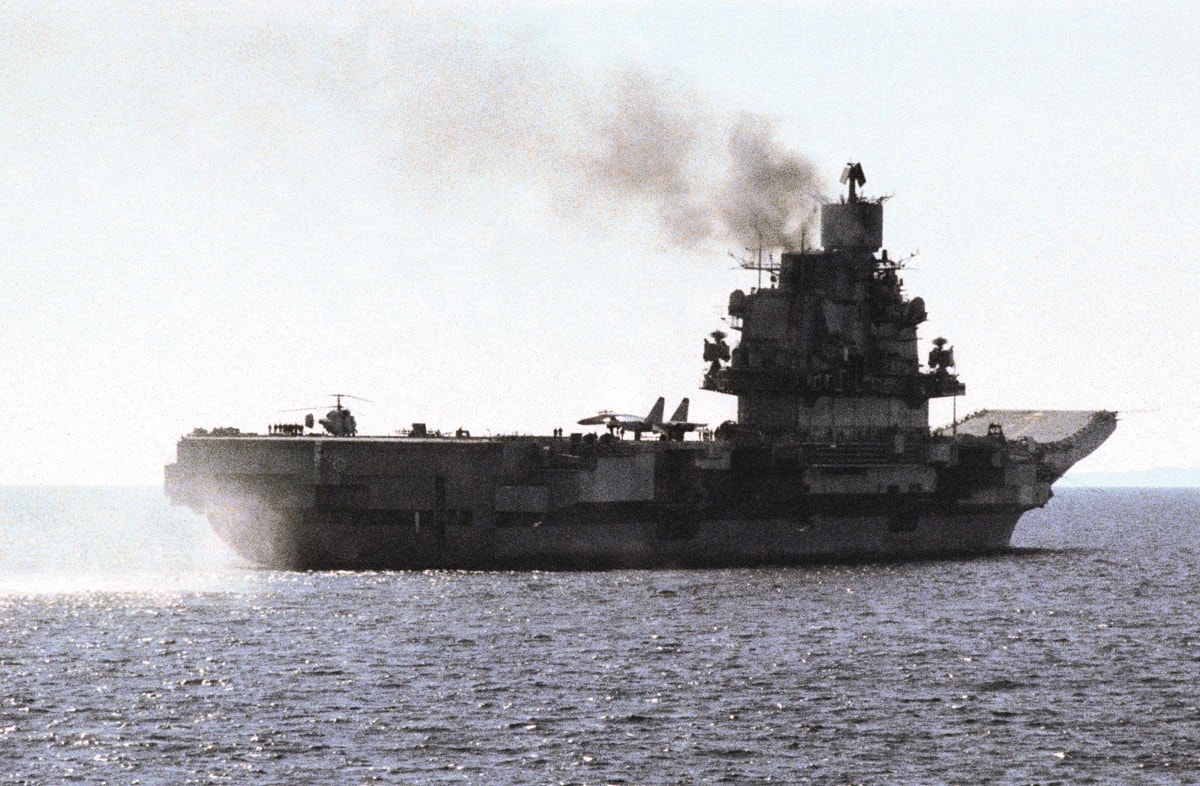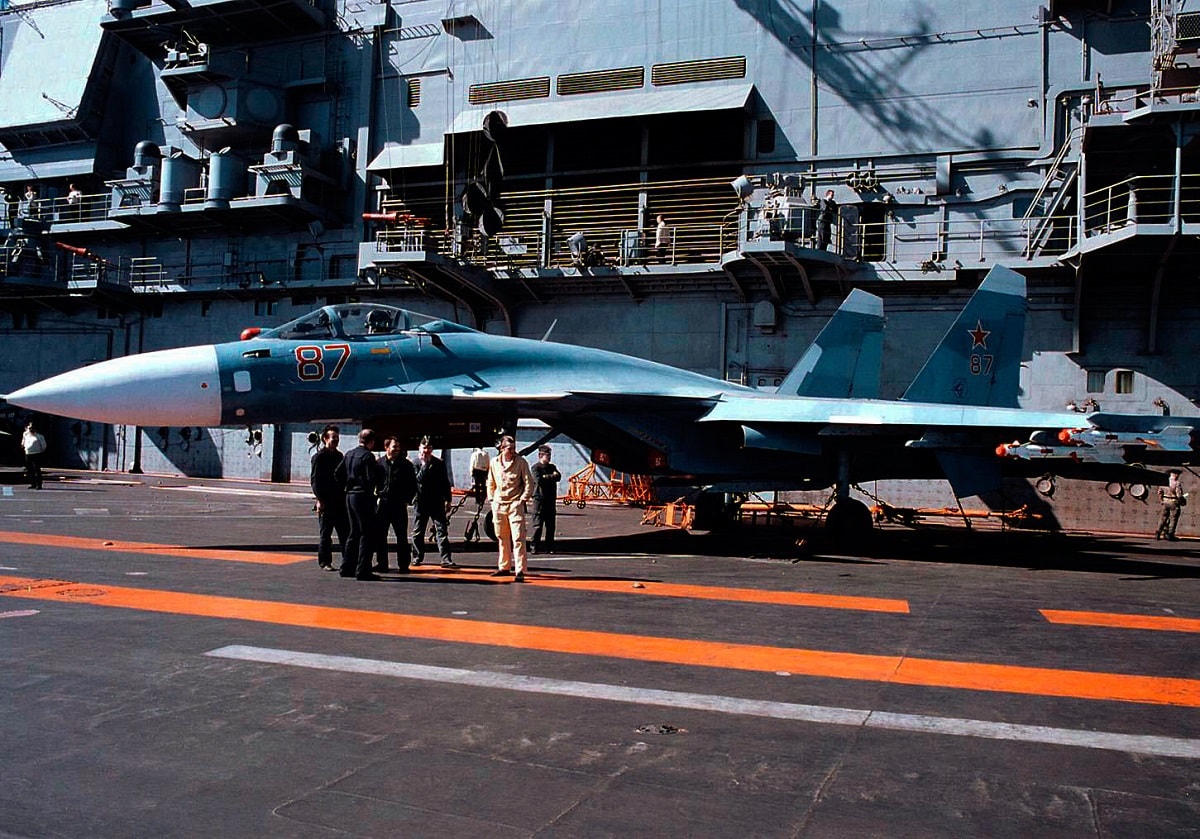Russia’s only aircraft carrier has been a maintenance disaster. Strangely enough, it seems Russia’s Su-33 fighter designed for service on this flattop might be just as awful.
Su-33, A Short History
Originally designated the Su-27K, the Sukhoi Su-33 was designed primarily for use on the Soviet Navy’s aircraft carrier, or what Moscow called its heavy aircraft cruiser Admiral Flota Sovetskogo Soyuza Kuznetsov. The single-seat, multi-role aircraft was not a new design, however. It was actually derived from the Sukhoi Su-27, but unlike its predecessor, which was limited to land-based operations, the Su-33 was modified for use on carriers and even had the capability of aerial refueling.
As an air superiority aircraft, the Sukhoi Su-33 (NATO reporting name “Flanker-D”) was meant to be able to destroy hostile aerial targets, provide fire support, and even take part in ground and sea attacks utilizing missiles and rocket bombs. In addition, it could be deployed to serve in an escort and reconnaissance role. While it performed its maiden flight in May 1985; it wasn’t until 1994 – after the fall of the Soviet Union – that the carrier-based conventional take-off and landing (CTOL) fighter finally entered service.
Despite the aircraft’s protracted development, the Su-33 has largely underwhelmed, and only around thirty-five have actually been produced, with the final aircraft entering service in 1999. In its quarter-century of operations, at least three of the aircraft have been lost in accidents, including one during a July 2001 air show in Russia, while in 2016 a Su-33 crashed during a landing attempt on the Admiral Kuznetsov. Following that accident, which was the second involving the fighter and the carrier, the remaining Flanker-Ds were transferred temporarily to ground-based operations.
Given that Russia only operates a single carrier, when it actually works well enough to go out to sea, it is not surprising that more of the fighters weren’t produced – but Moscow may have lost some faith in the Su-33 as it has more recently ordered a regiment of the shipborne variant of the Mikoyan MiG-29 multi-role combat aircraft. The MiG is smaller and lighter, making it more suited to carrier-based operations, but also is cheaper to produce and has lower servicing costs.
Exporting the Su-33
Russia had seemed to try to recoup on the Su-33 and looked to produce an export version. The People’s Republic of China had reportedly considered adopting the aircraft for its fledgling aircraft carrier program – fitting as the first People’s Liberation Army Navy (PLAN) carrier, Liaoning, was the former Varyag, sister ship of the Admiral Kuznetsov.
After negotiations with China stalled, India also considered adopting the Su-33 for its own former Soviet carrier, INS Vikramaditya but instead opted for the more compact MiG-29K.
It is quite clear that Beijing stands by its decision. Recently, Chinese military analysts touted the capabilities of the domestically produced Shenyang J-15 fighter, which is, in essence, a clone of the Su-33 based on a prototype acquired from Ukraine. The claims made by the Chinese officials came after Russian military experts suggested that the Su-33 was far ahead of the Chinese aircraft in tactical performance.
“There are huge design flaws in information equipment,” a Chinese analyst was quoted as saying by DefenceAviationPost.com. “Compared with China’s modern J-15 fighter, the Su 33 is obviously behind, and electronic system of J-15 is better than Su-33.”
Quite Capable?
The exact capabilities of the Su-33 haven’t exactly been put to the test, in part because the aircraft’s use in combat situations has been limited. However, the Flanker-D does have some noteworthy features including an airborne warning and control system is used to automatically detect, track, recognize and spot up to ten aerial and ground-based targets. In addition, the aircraft is equipped with a long-range navigation system that determines the fighter’s location based on the signals supplied by the ground station.

A starboard quarter view of the Russian Navy Northern Fleet aircraft carrier ADMIRAL FLOTA SOVETSKOGO SOYUZA KUSNETSOV exercising at sea.
Its avionics include a fire control system, flight navigation system, Doppler navigation radar, global positioning system, attitude and heading reference system, marker radio receiver, remote control system, and IFF (identification friend or foe) transponder, radar warning receiver, and radio jamming transmitter.
In terms of armaments, the Su-33 could be seen as a serious brawler. It is armed with 30mm Gsh-30-1 cannons and features a dozen external hardpoints for the mounting of R-27R1(ER1), R-27T1(ET1) and R-73E air-to-air missiles, S-8KOM, S-8OM, S-8BM S-13T, S-13OF and S-25-OFM-PU unguided missiles, Kh-25MP, Kh-31 and Kh-41 guided missiles, RBK-500 cluster bombs and electronic countermeasure pods.
Russia’s air force currently operates many aging yet proven aircraft. Yet, in the case of the Su-33, it is an aircraft that is an aging design but largely remains unproven–and a lousy track record when asked to perform.
Peter Suciu is a Michigan-based writer who has contributed to more than four dozen magazines, newspapers and websites. He regularly writes about military small arms, and is the author of several books on military headgear including A Gallery of Military Headdress, which is available on Amazon.com.

